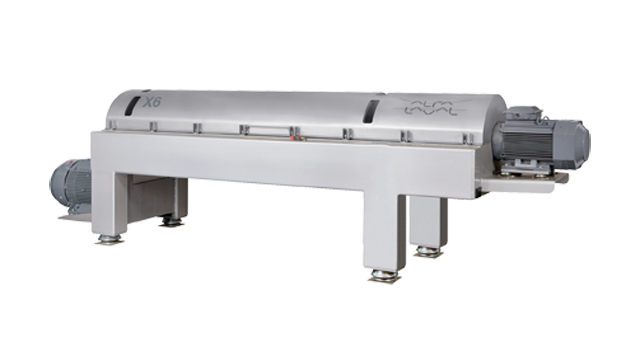Decanter duas fases para azeite de oliva (X)
Para operações de duas ou três fases, a série X de decantadores foi projetada para fornecer uma operação econômica na cadeia de produção de azeite.
Design features and benefits
The decanters feature a special system called Variable Dynamic Pressure (VDP). The geometry of the bowl and conveyor allows for a high pressure to be made on the solids before the discharge, thus being able to reach a higher level of dryness. Through the electronic control of the conveyor speed (differential speed) the level of this pressure can be adjusted and set to obtain the required degree of dryness.
Two-phase and three-phase
It is possible to use the same decanter for both two-phase and three-phase operation, on the basis of the differences in specific gravity.
In the three phase operation, the special features of the bowl geometry allow to utilize the so called ARA system. The ARA system controls the specific regulation of the decanter liquid level that both optimize quality of oil and water consumption.
The higher clarity of oil separated through the three phase process can be obtained with the addition of a lower amount of dilution water. This ensures a higher oil quality and reduced fresh water consumption. For the same reason, AISI 316 stainless steel is used throughout, and the casings are also made of stainless steel.
The design includes hinged casings for easy opening, maintenance and cleaning.
The decanters also have an overload protection system in either electronic or mechanical release version.
Como funciona
Operating principles
The decanter centrifuge design ensures separation of the incoming olive paste into three phases – oil, solids and water.
The olive paste is fed into the bowl through a stationary inlet tube and is then smoothly accelerated by an inlet rotor.
Separation takes place in a horizontal cylindrical bowl equipped with a screw conveyor. Centrifugal force causes instant sedimentation of the solids on the wall of the bowl.
The conveyor rotates in the same direction as the bowl, but at a different speed, and conveys the solids to the conical end. Because it is lighter, the oil flows on the inside, and the solids move towards the outer perimeter, while the water remains in the middle. Separation takes place along the entire length of the cylindrical part of the bowl.
The two liquid phases pass to their respective outlets via a vibrating filter and are then discharged into collecting tanks.

